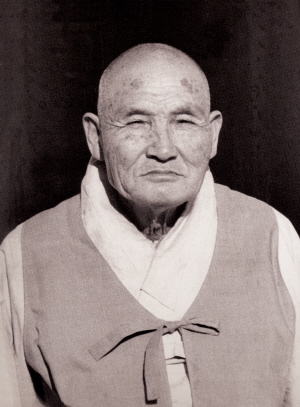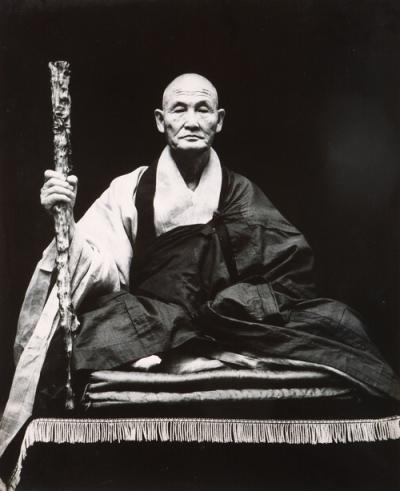ZEN MESTEREK ZEN MASTERS
« Zen főoldal
« vissza a Terebess Online nyitólapjára

경봉정석 / 鏡峰靖錫 Gyeongbong Jeongseok (1892-1982)
(Magyar átírás:) Kjongbong Csongszok

Gyeongbong Jeongseok (1892 ~ 1982)
http://www.koreanbuddhism.net/master/priest_view.asp?cat_seq=10&priest_seq=12
1. Career
Master Gyeongbong was born on April 9, 1892, in Miryang, Gyeongsangnam-do Province. When he was 14, after facing the unexpected passing of his mother, he constantly pondered life's fundamental questions, asking such questions as, "After we die, where does our soul go?" Thinking in this way, he heard from a monk that there was a method within Buddhism by which life and death could be transcended, and in 1907, at the age of 15, he ordained at Tongdosa monastery.
Following his ordination, he graduated from the newly established Myeongsin school as well as the Buddhist studies school, upon which he was charged with administrative duties at Tongdosa. Filled with thoughts that he must become enlightened to the Buddhahood, he wasn't able to remain enthusiastic about his work. So one day while studying the scriptures, reading the phrase, "though you may count another man's riches all day long, you won't even profit a half-penny's worth,"he received a great shock and determined at that point that he would enter into Seon meditation.
In 1915, at the age of 23, he left Tongdosa to enter the Seon center at Haeinsa. However, after he received a number of messages from his vocation master (who is the monk that first shaves a novice monk's head upon completion of his or her postulanthood) telling him to return to Tongdo-sa, he set off to travel around to numerous Seon centers and temples, immersing himself in Seon meditation practice. Only after jd could immerse himself into his hwadu to some extent, past the age of 30, did he again return to Tongdosa.
In 1925, his fellow monk with whom he had studied together, suggested one day, "By donating 20 bushels of rice each every year, we should build a center for chanting practice together." Gyeongbong sunim felt that it would be good to provide a space for monks and laypeople to practice intensive chanting meditation together and a place of comfort for the elderly who have no place or no one to depend on. Thus, the "Society for 10,000 Days of Chanting Practice for the Elderly" was established at the Geungnagam Hermitage.
In the winter of 1927, the year he turned 35, Master Gyeongbong held a service at Geungnagam Hermitage to preach a sermon on the Flower Adornment Sutra (the Hwa-eom Sutra). Starting on the first day of the sermon, his hwadu began appearing to him with an extraordinary clarity, and on the fourth day of the services his sights bursted wide open as if a wall in front of him suddenly gave way, and he experienced the boundary of the complete and perfect image of the "universal circle" (irwonsang). The morning of the following day, he experienced the state of "not two," where one's self and the universe are not separate.
Though he came upon the edge of enlightenment twice, the doubt about his hwadu was still not completely released and so he again entered into absorption in his hwadu. The following early dawn, though there was no wind, the candle made a "flutter, flutter" sound and in the moment the flame danced, Gyeongbong slapped his knee, gave out a roaring laugh, and dashed outside. The heap of doubt that had persisted despite his strenuous efforts finally dissolved to make way for his self-nature. Intoxicated in the world of great freedom after twenty years since his entrance in the sangha, he danced alone under the full moon.
Having searched for myself in all myriad things
True Self (Juingong, lit. protagonist/hero or main actor) appeared right before my eyes
Ha! Ha! Meeting it now, there is no doubt
Brilliant hues of udumbara flowers spill over the whole world
Master Gyeongbong's first serious step in the path towards the enlightenment of all beings began at age 38 in February 1930, by his appointment to the position of Director of the Buddhist Seminary in Tongdosa. Transcending the difference between Meditative Practice and Doctrinal Study with his enlightenment, his unbending labors to awaken all beings only came to an end fifty years later. After serving in various positions, including head priest of Tongdosa, Gyeongbong took the position of head master of the Hoguk Seonwon center in November 1953 at Geungnagam Hermitage, where he would stay until his entering nirvana. During this thirty-year residence at Geungnagam Hermitage, he would guide the way of truth to monastics and lay practitioners who were seeking the dharma.
Starting at the age of 81, on the first Sunday of every month, he held regular services that drew a crowd of a thousand people that wished to hear his sermons. Even at the age of 90, with the aid of his disciples, he would rise to his position on the dharma seat to give dharma talks. Unlike other masters, he would usually preach from his own experiences, rather than relying on using quotations from the records of the Patriarchs.
On July 17, 1982, after summoning his disciple Myeongjeong, who asked, "Even after Master departs, I still wish to meet you. What is your true appearance?" he replied, "Try touching the wooden crossbar of the main gate deep in the night in the third hour" and then entered nirvana at that age of 91.
2. Writings
Adept at Chinese poetry and brush and ink, Master Gyeongbong also left behind many paintings and calligraphic works. In addition, from the age 18 until his passing at the age of 90, he unfailingly recorded the important events of each day in his journal, a work that allows us to see a detailed picture of the state of society as well as the conditions of Korean Buddhism in his day. After his enlightenment, Master Gyeongbong also engaged in continued correspondence with the acclaimed Seon masters of his time, including Masters Hanam, Mangong, and Yongseong. In particular, his correspondence with Master Hanam concerning the practice of Seon meditation is captured in twenty some letters, and owing to Master Gyeongbong's safekeeping, those valuable texts still exist today. His disciple Myeongjeong compiled these materials in the 1994 text, Gyeongbong Daeseonsa Seonmuk, and the 1979 work, Gyeongbong Daeseonsa Beobeojip. Myeongjeong sunim, while editing works such as the compilations of the Master's dharma talks, calligraphy and artwork, has spent over fourty years protecting the Geungnagam Hermitage from which Master Gyeongbong had departed.
3. Intellectual Distinction
To achieve enlightenment, Master Gyeongbong investigated the "what is this?" hwadu, bringing him to the edge of enlightenment on two occasions. This was the state of the "universal circle" and "not two"; the dissolving of the boundary between self and others, subjectivity and objectivity, as expressed in the singular form of a circle. And in this he experienced that all phenomena that appears before the senses are created by the mind, and that that mind is also the ordinary mind. Therefore, he had experienced the truth that all existence as it is, in nature, is in a relationship where it and the self are not two. The only difference between the minds of sentient beings deluded by illusory thought, and those of an enlightened mind, is the ability to vividly and clearly see the universe without suffering or conflict. As described in the Master's journal one year later, this is the experience of "Tathagata Seon."
Nevertheless, his heap of doubt that remained though he strove so diligently in his investigation of the "what is this?" hwadu only melted away through his enlightenment while hearing the sound of a candle fluttering in the wind. This awakening was not merely an intellectual confirmation of a reflection on self-nature; it was an empirical awakening brought by the vivid confirmation of the true form of the True Self (Juingong) when he had driven himself into a state so full of doubt that there was no escape. The Juingong had in fact never been far from himself. Finally then, Master Gyeongbong had experienced the meaning of Patriarchal Seon.
Looking with the eye of enlightenment, everything became so completely self-evident. In his dharma talks, he said, “Why don't the sentient beings understand that their eyes and ears are masked in the darkness of delusion, so they are entirely unable to see or feel this -- that the immeasurably luminous realm of the Dharma nature is as it always used to be, where the light of the moon is always transparent and the wind is always fresh?”
And Master Gyeongbong also compared life to a dream. Once he said, “even if all the sentient beings in the entire universe lived for one hundred years, if they are unable to see the true Juingong, they are simply in a slumber within a dream.” He wondered why he had even sought the Buddha from so far away, the object of such fervent belief, feeling as though he existed separately in some distant realm. In the eyes of the Master, he could experience the Buddha firsthand, who was 'right in front of my eyes, as familiar as my own name.'